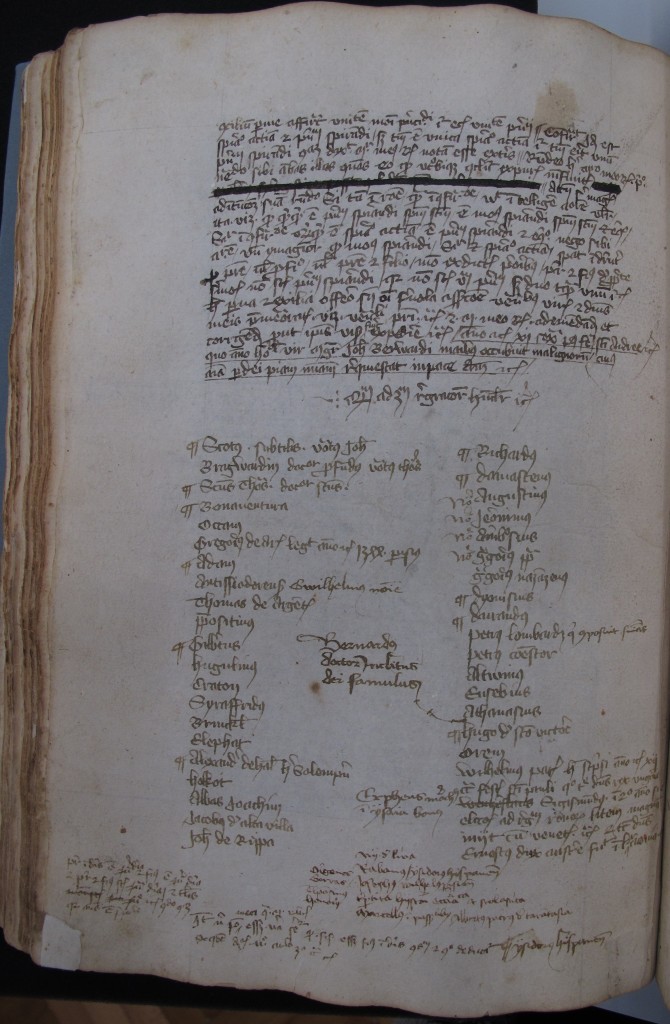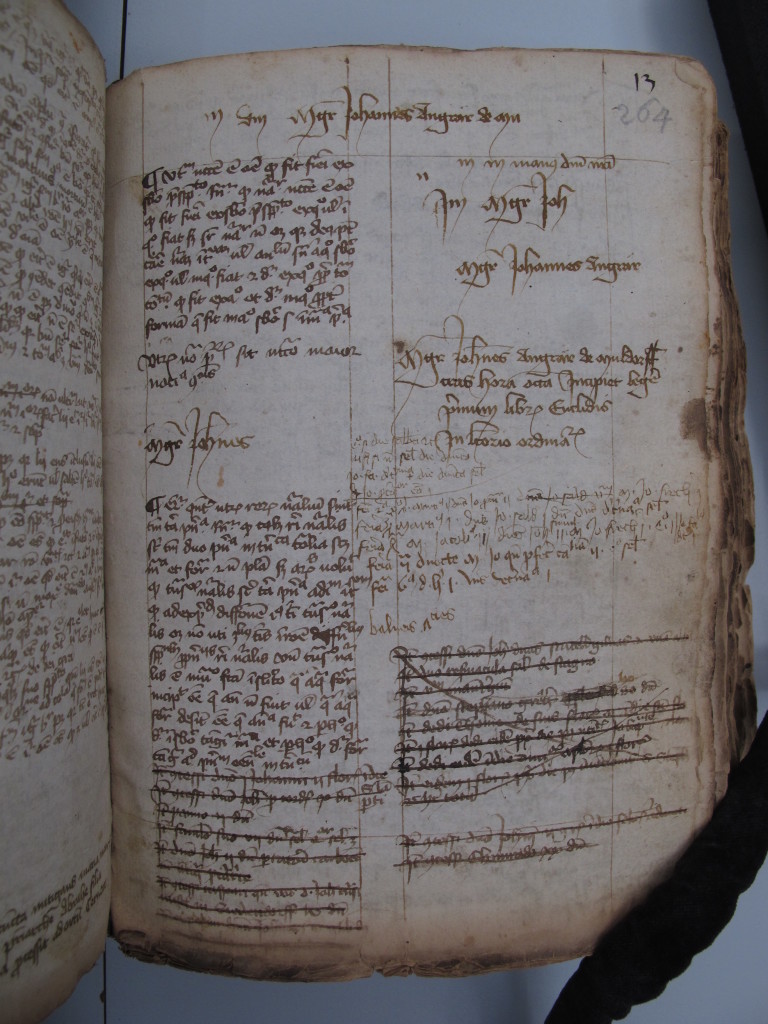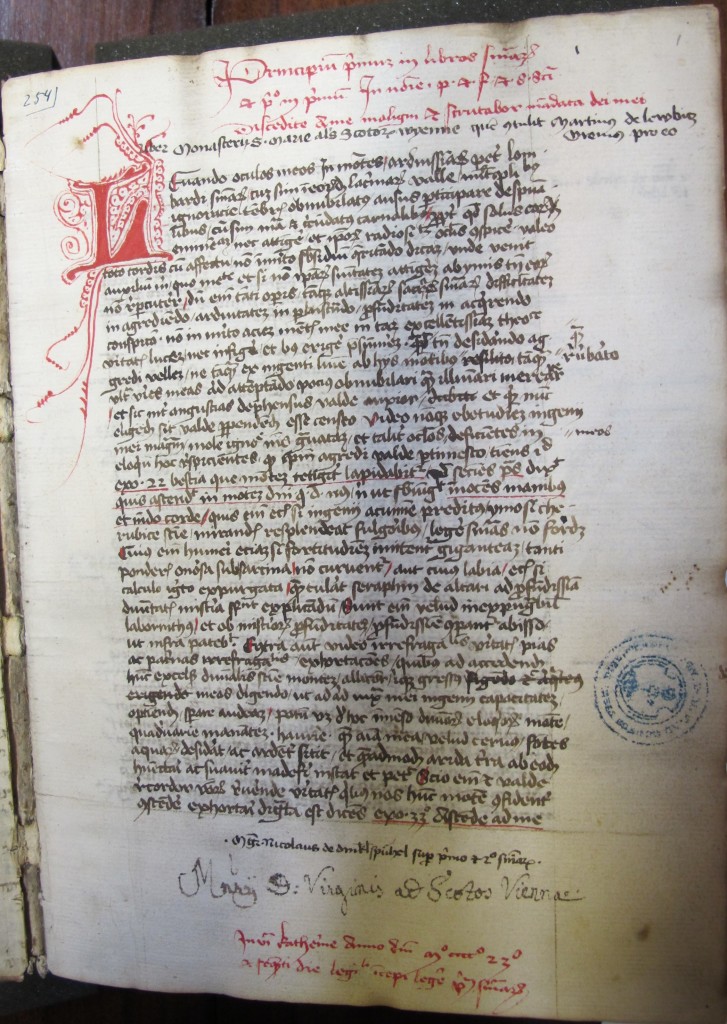We should have been aware of it for a long time. At least since it was established that even the charter of privileges of the University was written by one of its theologians: Paul of Geldern, an influential clerk from the early Faculty of Theology in Vienna, drafted the University’s solemn charter in 1384.[i] Paul of Geldern was indeed one of the most zealous scribes from the first generation of Viennese theologians. He wrote not only to carry out a command of Duke Albrecht III, but also to lay down, among other works, the first part of the majestic commentary on Genesis, produced by his colleague Henry of Langenstein and preserved in Vienna ÖNB Cod. 4841, his own principial lectures and Sentences commentary in Erfurt CA fol. 173, or a disputed question in Erfurt CA fol. 60.[ii]
So it should come as no real surprise that the Viennese theologians wrote many texts in their own hands. When speaking of their duties at the University, especially the Faculty’s administration[iii] and significant teaching matters appear to have been written by the deans and the teachers. Faculty acts have long been studied and edited. But why not put aspects of Viennese teaching under the palaeographical magnifying glass? From the Faculty of Theology, the Sentences Commentaries and their introductory lectures, the so-called principia emerge as a first relevant subject of enquiry.[iv] The most valuable witness in this field is Nicholas of Dinkelsbühl’s handwritten commentary from the beginning of the 15th century, preserved in Vienna Schottenstift 269 (274). Dinkelsbühl’s commentary is identified as the main source for his contemporaries in the Vienna Group, who copied and reused the text of their common master in their own lectures on Lombard’s Sentences producing the so-called Vienna Group Commentary.[v] Now these copy-pasted commentaries were very often written by the re-users themselves, as is evident in some manuscripts held in Vienna. Peter of Pulka, who lectured on the Sentences between 1403 and 1405, left the commentaries on Book I, II and III along with biblical and sentential principia in autograph manuscripts in ÖNB Cod. 4668, Cod. 4713 and Cod. 4939.[vi] One further example from a decade later has long been unknown; however it belongs to the prominent Viennese intellectual, John of Gmunden. Paul Uiblein noticed as early as 1973 that ÖNB Cod. 4422 must contain Gmundenʼs commentary on Book II of the Sentences.[vii] Not only did the manuscript belong to Gmunden, but it was written down by him for its major part. Moreover, the watermarks allow a precise dating of the codex to the years when Gmunden lectured on Lombardʼwork: the biennium of 1416–17.
Sometimes, autograph marks are more restrained. ÖNB Cod. 5067’s principia and the commentary on Book I of the Sentences have recently been identified as belonging to John Angrer of Müldorf.[viii] Besides the arguments already listed, one palaeographical proof could be introduced in favour of Angrer’s authorship, or more precisely, against the long supposed authorship of John Wuel of Pruck, the scribe of ÖNB Cod. 5067. For the explicit of John Wuel of Pruck is followed by a further remark in a different hand: “In die sanctorum Gervasy et Prothasy finivi primum Sententiarum legendo anno etc. vicesimo secondo.” This second hand, using the first person singular for having lectured on Book I of the Sentences in 1422, must be that of the author of the commentary on Book I.
The same pattern of dating lectures secundum alium in one’s own hand seems to have been used much later by the Dominican Professor, Leonard Huntpichler. Huntpichler lectured in 1446 on Book III of the Sentences of Narcissus Herz of Berching, as can be deduced from Cod. 109/75 of the library of the Viennese Dominicans. Cod. 109/75 contains the Commentary of Narcissus along with a principium, ample marginal notes and a dating alternately from Leonhard Huntpichlerʼs or his secretaryʼs hand. On f. 135r, it is nevertheless Huntpichler who notes and confirms his lecturing secundum Narcissum: “Distinctio 22. Hanc legi anno 46 in vigilia assumptionis in alma universitate viennensi in Austria.”[ix]
In contrast to the collective Sentences commentaries of the Vienna Group, the principia reflected faculty debates and substantiated individual positions of the lecturer starting his courses. From the early 15th century, ÖNB Cod. 4593, ff. 100r–126v contain the sentential principia and lists of question from biblical commentaries of Theodoric Rudolfi of Hammelburg. These principia can be ascribed to Theodoric, since Paul Uiblein has already identified his handwriting in this part of the manuscript,[x] and also for many concordant elements. The principia are dated to 1411 and 1412, and do refer to the concurrently reading John of Basilea OP, at that time prior of the Viennese Dominicans, and Ulrich of Patavia. Incidentally, they contain the protestaciones stipulated in the Faculty statutes.[xi]

ÖNB Cod. 4593, f. 112v: Explicit of the second principium on Book IV of the Sentences dated to 1411 and a list of authorities
One further example of principia written in the author’s own hand is to be found in Schottenstift 254 (230). This other manuscript of the Viennese Benedictines holds a Sentences Commentary attributed to Nicholas of Dinkelsbühl gathered by Martin of Lewbicz OSB, in which the first folios enclose a set of principia written in a hand different to the rest. Among the candidates for the authorship of these principia (Andreas of Waytra, Urban of Melk, John Nider OP) from 1423–25,[xii] Andreas of Waytra appears most likely to have drafted, corrected and added marginalia to these pages; in other words he is the author of these principial lectures.[xiii]
An example dated exactly ten years later is supplied in ÖNB Cod. 4719, ff. 16r–51r carrying the autograph sentential principia of Thomas Wölfel of Wuldersdorf.[xiv]
Putting together these more or less recent pieces of the jigsaw offers a rather elaborate picture of the Viennese practice of Sentences commentaries. We realise that we are presented with so many autographs of Sentences commentaries or their principia in Vienna that writing these texts in one’s own hand must have been the silent, but persistent rule, irrespective of the degree of “originality” of the content. Appealingly for our concept of the Vienna Group Commentary, quasi identical Sentences commentaries appear to have been patiently copied or provided with meticulous marginalia, undermining the theory of pointedly careless Viennese theology. Handwriting denotes individuals within the common project of the Vienna Group. While authorship must finally be attributed to the selection of certain texts which constitute the Sentence commentary of a Peter of Pulka, a John of Gmunden or a John Angrer of Müldorf, it is nevertheless primarily identical with handwriting.
Finally, whichever generation we look at, Viennese theologians from Paul of Geldern onwards offer us handwriting as a typically individual feature magnifying their own efforts. This should definitely encourage us to recognise the subtle doctrinal differences between particular authors.
[i] Ch. Lackner, „Diplomatische Bemerkungen zum Privileg Herzog Albrechts III. für die Universität Wien vom Jahre 1384“. MIÖG 105 (1997) 114–29.
[ii] Many thanks to Christian Lackner for ascribing the disputed question in Erfurt CA fol. 60, ff. 66r˗v to Paul of Geldern. For Erfurt CA fol. 173 see M. Sokolskaya, „Paul von Geldern – ein Wiener Universitätstheologe aus dem Ende des 14. Jahrhunderts. Zur Handschrift 2°173 der Collectio Amploniana zu Erfurt“. Jahrbuch für mitteldeutsche Kirchen- und Ordensgeschichte 8 (2012) 193-236.
[iii] P. Uiblein, Die Akten der Theologischen Fakultät der Universität Wien (1396–1508) (AThF) (Vienna 1978), 2 vols.
[iv] I am working on an updated list of Bible commentaries from the University of Vienna (1384–c. 1420), several of which were also written down by the authors themselves.
[v] M. Brînzei – Ch. Schabel, „The Past, Present, and Future of Late Medieval Theology: The Commentary on the Sentences by Nicholas of Dinkelsbühl, Vienna, ca. 1400″, in Ph.W. Rosemann, Mediaeval Commentaries on the Sentences of Peter Lombard (Leiden 2015), vol. 3, 174–266.
[vi] P. Uiblein, „Zur Lebensgeschichte einiger Wiener Theologen des Mittelalters“, in Id., Die Universität Wien im Mittelalter (Vienna 1999), 326–28.
[vii] P. Uiblein, „Zur Biographie des Johannes von Gmunden“, in Beiträge zur Kopernikus-Forschung (Linz 1973) 35; Id., „Johannes von Gmunden. Seine Tätigkeit an der Wiener Universität“, in Id., Die Universität Wien im Mittelalter, 363–4.
[viii] W. J. Courtenay, „From Dinkelsbühlʼs Questiones Communes to the Vienna Group Commentary. The Vienna ‘Schoolʼ, 1415–1425″, in M. Brînzei (ed.), Nicholas of Dinkelsbühl and the Sentences at Vienna in the Early Fifteenth Century (Turnhout 2015) 287–291.
[ix] F. Lackner, „Das Principium im Cod. 109/75 des Wiener Dominikanerkonventes“, Codices manuscripti 5 (1979) 48–57.
[x] P. Uiblein (ed.), Dokumente zum Passauer Bistumsstreit von 1423 bis 1428 (Vienna 1984) 362.
[xi] R. Kink (ed.), Geschichte der kaiserlichen Universität Wien (Vienna 1854) vol. 2, 102 (online). For more about the protestaciones see Ueli Zahnd, „Disputing without socii. The Principium on Book IV of Conrad of Rothenburg, Vienna 1408–09″, in M. Brînzei – W. Duba (eds.), Les principia sur les Sentences. Entre exercice institutionnel et débat philosophique (Turnhout 2017), forthcoming.
[xii] Courtenay, „From Dinkelsbühlʼs Questiones Communes to the Vienna Group Commentary“, 291–3.
[xiii] I thank Martin Wagendorfer, who kindly confirmed my supposition. I would nevertheless leave the question open, whether the commentary included in Schotten 230 also belongs to Andreas of Waytra.
[xiv] Uiblein, Die Akten der Theologischen Fakultät, 474, note 667. For other evidence see Courtenay, „From Dinkelsbühlʼs Questiones Communes to the Vienna Group Commentary“, 293–5.
Uibleinʼs notes in volume 2 of the AThF provide more identification of autograph manuscripts than those randomly quoted above.



On my last visit to the library of the Scottish monastery in Vienna, on Thursday 19 May, I asked the librarian, Alexander Trofaier, whether the initials in Cod. 254 (230), so different in execution, have already been studied. Opening „Mitteleuropäische Schulen V (ca. 1410–1450). Wien und Niederösterreich“ (Wien 2012) on p. 266, we were somewhat astonished to discover that Andreas de Waytra was not only one of the scribes actively involved in the codex, but also the person who illuminated two initials (f. 1 and 100v). Beyond the confirmation of my hypothesis regarding the authorship of the principia included in Schottenstift 254 (see my post above), this overlap poses the question whether there is an efficient exchange of information regarding manuscript studies.
However, fortunately, there is more than one poetic question! As stated in „Mitteleuropäische Schulen V (ca. 1410–1450)“, p. 266, Andreas of Waytra wrote sections of the Sentences Commentary included in codex 254, for instance from f. 368v. I would add that many of the marginal commentaries, in particular those included on cedulae are in the hand of Andreas of Waytra; thus he also authored the Sentences Commentary included in Schottenstift 254. Here we held the evidence that the principia and the Sentences Commentary bound together in one manuscript belong to the same author. This is one further pattern of the Viennese manuscript tradition regarding Sentences Commentaries we should continue to carefully examine and confirm manuscript by manuscript, author by author.